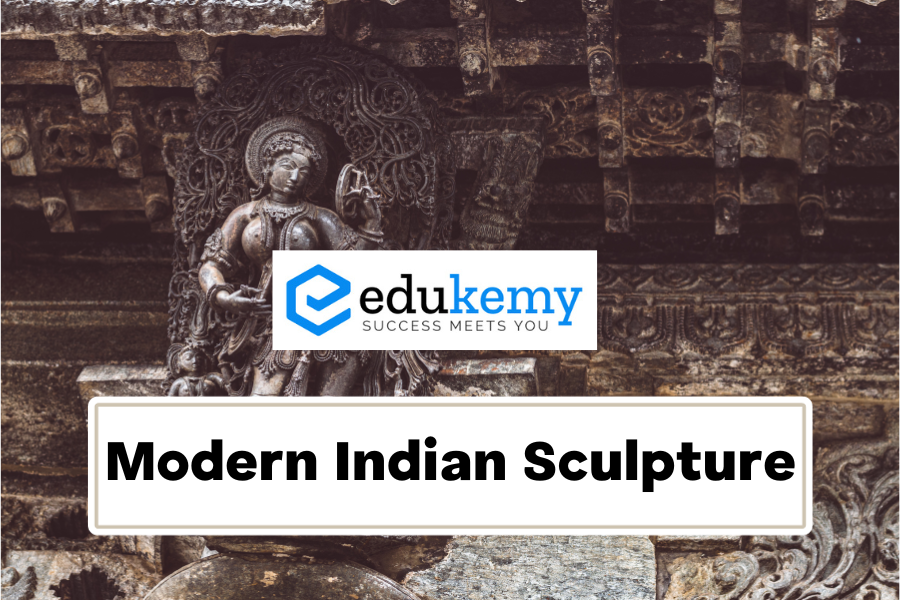
Modern Indian sculpture has undergone a fascinating journey of transformation, influenced by a myriad of factors, including changing societal norms, the impact of foreign colonialism, and the assimilation of international artistic concepts.
- The Legacy of Academic Realism
The foundations of modern Indian sculpture can be traced back to the academic style prevalent during the mid-Victorian era. This style was heavily influenced by British colonialism, perpetuated through government art schools and colleges established in cities like Bombay, Calcutta, and Madras. Unfortunately, this so-called “realist” or “naturalist” school never reached the heights of academic excellence and remained far removed from the rich iconographic, symbolical, and religious ideals that had characterized Indian sculpture through the ages.
- Transition to Western Influences
By the 1940s, Indian sculpture, much like contemporary painting, began to look to the Western world for inspiration. This marked a period of experimentation and eclecticism, with artists exploring unconventional materials such as sheet metal, welded bric-a-brac wire, plastic, hardware, and junk. While some sculptors achieved noteworthy results in harmony with their milieu, the field remained primarily concerned with shape, form, texture, and abstraction.

- Renewed Interest in Folk and Tribal Art
While modern Indian sculpture was exploring new artistic avenues, it also witnessed a renewed interest in folk and tribal art traditions. This movement emphasized directness, simplicity, and a singular stylized approach to artistic expression. These influences breathed fresh life into contemporary Indian sculpture and added layers of meaning to the evolving artistic landscape.
| Prominent Artists and Their Contributions Nandalal Bose: A distinguished pupil of Abanindranath Tagore, Nandalal Bose’s work showcased simplicity and directness, influenced by the vitality of folk art. His paintings often drew from everyday life, infused with a profound sense of pictorialism.Jamini Roy: A contemporary of Nandalal Bose, Jamini Roy charted a unique artistic path, deeply inspired by Bengal’s folk tradition. His work featured direct, stylized images with emphatic flat spaces and strong lines.Ganganendranath Tagore: An individualist of extraordinary talent, Ganganendranath Tagore’s paintings shared commonalities with cubism. His work was marked by a dramatic concept of light and shadow, setting him apart as an artist with a distinctive vision.Rabindranath Tagore: Although primarily known as a poet, Rabindranath Tagore ventured into painting in his later years. His images emerged from the subconscious, dreams, and fantasies, bearing an archetypal quality.A.A. Almelkar: Almelkar’s work was rooted in Indian miniature and mural traditions, but he introduced a highly individualistic approach to compositional problems. |
Modern Indian sculpture, much like contemporary painting, has embarked on a diverse and ever-evolving journey. While it initially strayed from the traditional Indian sculptural heritage, it eventually found its own path, incorporating influences from folk and tribal art traditions and experimenting with unconventional materials and forms. Prominent artists from this era have left indelible marks on the art world, each contributing to the evolving narrative of modern Indian sculpture. This dynamic blend of tradition and innovation continues to shape the contemporary Indian artistic landscape, reflecting the ever-changing nature of creative expression.
Contents
- 1 Frequently Asked Questions (FAQs)
- 1.1 1. FAQ: What defines Modern Indian Sculpture, and how does it differ from traditional forms?
- 1.2 2. FAQ: Who are some prominent figures in Modern Indian Sculpture?
- 1.3 3. FAQ: How has technology influenced Modern Indian Sculpture?
- 1.4 4. FAQ: What are the prevalent themes in Modern Indian Sculpture?
- 1.5 5. FAQ: How is Modern Indian Sculpture received on the global stage?
- 2 In case you still have your doubts, contact us on 9811333901.
Frequently Asked Questions (FAQs)
1. FAQ: What defines Modern Indian Sculpture, and how does it differ from traditional forms?
Answer: Modern Indian Sculpture emerged during the 20th century and is characterized by a departure from traditional styles. While traditional sculptures often focused on religious themes and were predominantly made of stone, modern sculptures explore a wide range of materials and themes, reflecting social, political, and cultural changes. Artists experiment with forms, materials, and concepts, moving away from strict adherence to classical norms.
2. FAQ: Who are some prominent figures in Modern Indian Sculpture?
Answer: Notable sculptors in Modern Indian Sculpture include Ramkinkar Baij, Dhanraj Bhagat, Meera Mukherjee, and Ravinder Reddy. These artists have significantly contributed to the evolution of sculptural expression in India. Their works often showcase a blend of traditional techniques with innovative approaches, addressing contemporary issues and pushing the boundaries of sculptural art.
3. FAQ: How has technology influenced Modern Indian Sculpture?
Answer: Technology has played a crucial role in shaping Modern Indian Sculpture. Contemporary sculptors utilize a variety of tools and techniques such as 3D printing, digital modeling, and other modern materials. This integration of technology allows artists to experiment with new forms, textures, and sizes, expanding the possibilities of sculptural expression beyond the limitations of traditional methods.
4. FAQ: What are the prevalent themes in Modern Indian Sculpture?
Answer: Modern Indian Sculpture explores a diverse range of themes, reflecting the dynamic nature of Indian society. Common themes include social issues, identity, gender, environmental concerns, and globalization. Artists often draw inspiration from their cultural roots while addressing contemporary challenges, creating sculptures that serve as powerful statements and reflections of the times.
5. FAQ: How is Modern Indian Sculpture received on the global stage?
Answer: Modern Indian Sculpture has gained international recognition and appreciation. Many Indian sculptors have exhibited their works globally, contributing to a cross-cultural dialogue. The fusion of traditional Indian elements with contemporary global influences resonates with audiences worldwide, showcasing the richness and versatility of Modern Indian Sculpture on the global art scene.
In case you still have your doubts, contact us on 9811333901.
For UPSC Prelims Resources, Click here
For Daily Updates and Study Material:
Join our Telegram Channel – Edukemy for IAS
- 1. Learn through Videos – here
- 2. Be Exam Ready by Practicing Daily MCQs – here
- 3. Daily Newsletter – Get all your Current Affairs Covered – here
- 4. Mains Answer Writing Practice – here

